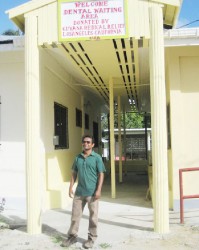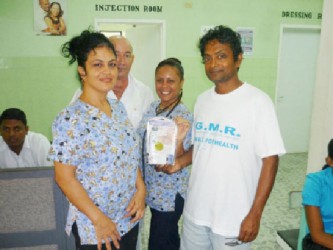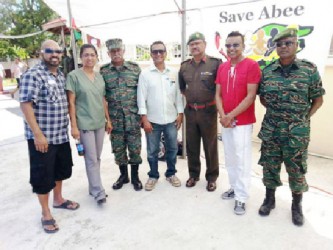For the past 30 years, the Guyana Medical Relief (GMR) has touched the lives of many through its major donations to hospitals and health centres throughout the country.
The organisation which is based in Los Angeles, California says it has sent a large amount of medicines and medical supplies to Guyana. It has worked closely with the Ministry of Health to ensure that the shipments are distributed efficiently.
Sharir Chan, Chief Operations Officer said the GMR has also executed other projects that have helped with the enhancement of health facilities in Guyana.
The latest project, he said, was the refurbishing of the Accident & Emergency Unit of the Port Mourant Hospital to a modern facility.
Chan said the project was dedicated to and in honour of GMR’s founder, Eula Kennard-Menzies, and was handed over to coincide with the 30th anniversary of the organisation.

Kennard-Menzies, who hailed from Port Mourant and whose father also happened to be among the first doctors at the hospital, was described as the matriarch of the Guyanese community in Los Angeles.
The GMR was founded in 1984 after the founder recognised the need to help in the local health care system.
The organisation’s original mission was working in close partnership with Direct Relief International of Santa Barbara, California which obtains the majority of the equipment and medical supplies.
But after Kennard-Menzies recognised the great need she decided to get more involved in helping directly and so the GMR was born.
Chan, the face behind the local projects, has been stretching himself thin as he goes out of his way to ensure they are completed successfully. He also monitors the distribution of the medical supplies.
The organisation is mainly involved with the hospitals at New Amsterdam, Bartica, Linden, Suddie and Mahaicony as well as the “satellite clinics surrounding those hospitals” and two private facilities: the St Joseph and Davis Memorial hospitals.
Chan said the organisation is “looking at establishing a presence at Mabaruma in Region 1 and Lethem in Region 9.”
It has also partnered with the Save Abee Foundation of Florida that is based at Cotton Tree, West Coast Berbice and the Cane Grove Reunion of New York along with other independent non-governmental organisations.
The GMR has been teaming up with the Berbice Regional Health Authority with the aim of enhancing its home-based care programme.
“We hope to help them to institutionalise it so that they can use it as a model for the rest of the country,” Chan said.
In addition, the GMR had built its first visual inspection with acetic acid (VIA) clinic at the Mahaicony Hospital before moving on to do the same in Bartica and at Charity, Essequibo
The clinics, he said, were built as a way of assisting in “elevating the health of women and children.”


This year, the organisation completed the construction of a storage bond as well as a dental waiting area at the Mahaicony Hospital. It also donated two four-drawer freezers each to the Mahaicony and Fort Wellington hospitals.
The GMR is “looking to partner with community-minded NGOs like Buxton, Sophia and other communities in the interior,” Chan said.
It has also recently completed its first series of medical outreaches together with the GDF medical corps through Save Abee Foundation and the Cane Grove Reunion. Over 1,000 persons benefited from the free clinics which were dubbed as highly successful.
In an effort to assist with children’s health care, the organisation has teamed up with the California-based Toms Shoes, to provide a pair of footwear to each needy child who undergoes a health check at the schools.
Chan, the holder of a master’s degree in International Relations and a former California-trained teacher said the GMR has grown over the years and he believes that it is “arguably the longest running NGO of Guyanese origin in the diaspora.”
He said the organisation sustains itself through fund-raisers, including its annual dinner and dance, which was held on October 11.
According to him, there would also be walk-a-tons around the Rose Bowl area at springtime every year where members would be sponsored during the “walk for health” as they “collect donations along the way.”
Meanwhile, the organisation which is governed by a board of directors also generates income from its “annual membership drive” that includes of “hundreds of sustainers” with many giving “big donations,” he said.
Chan said although the projects and distribution of supplies take a lot of his time, he enjoys being a part of it as it helps to improve the lives of others.
He said “many people are born into poverty and don’t know how to address it. When people have to struggle to feed their bellies they really do not have the capacity to make the necessary changes to improve their [health] conditions.”
He recognises that there are social issues but pointed out that “in life where there is a lack of hope it takes the community-minded people; teachers, doctors, nurses, neighbours, everyone, from the diaspora to come together to elevate our consciousness materially and spiritually – to enable us to change, to find hope.”





